Review and images by callmejoe3; edited by bmathison1972
Today’s review will cover the Northern Pacific voyager, the gray whale (Eschrichtius robustus). The gray whale is a very well-known mysticete due to frequent sightings during whale-watching tours along the American west coast. Gray whales were also known as the ‘’Devil-fish’’ due to the aggression they display when defending against whalers and natural predators. It is the sole member of its genus, Eschrichtius. Gray whales were once postulated by some experts to be phylogenetically basal baleen whales, as it seemed to be phenotypically intermediate to rorquals and balaenids. However, modern genetic studies place it within the rorqual family. There are no identified subspecies, but eastern and western North Pacific subpopulations are recognized; though, mixing is still known to occur even between these groups. The eastern population is the most well known, mostly inhabiting shallow waters off the continental shelves near the coasts, though they may occasionally feed in deep ocean basins. These individuals travel anywhere from 10,000-22,512-kilometer round trips between the Arctic for summer feedings and Mexico for winter breeding. A North Atlantic population once existed before it became extinct in the 1700s. Despite this, recent sightings of gray whales off the coasts of Spain, Israel, and even Namibia have been documented in the past decade. These sightings are speculated to be the result of distribution changes coinciding with the loss of ice in the Arctic. On average, gray whales measure in at 11-15 meters in length and 16-30 tons in mass, with females slightly larger than the males. The maximum recorded size is 15.6 meters and 40 tons. The eastern population has been declared ‘Least Concern’ by the IUCN since 2017 with an estimated population of 26,960 individuals. This population made a dramatic comeback as commercial hunting brought it to near-extinction in the early 20th century. The western subpopulation holds an ‘Endangered’ status with only a few hundred individuals estimated. Limited aboriginal hunting and climate change remain as areas of great conservational concern. Gray whales are primarily suction feeders that skim along the ocean floor, with most preferring the face the ground on their right side. However, they are capable of skim-feeding and gulp-feeding like right whales and rorquals. They feed mainly on small crustaceans such as amphipods and mysids while opportunistically feeding on a more varied diet of crabs, baitfish, and squid. Gray whales are preyed upon by Bigg’s killer whales and large sharks as calves.

In 2000, Schleich released a sea-life lineup which included a sperm whale, humpback whale, and gray whale produced by Maia and Borges. Once these figures were retired in 2012, the M&B sculpts were re-released by other brands such as Papo and Mojo Fun. I have previously covered the M&B sperm whale, where I compared each of its re-releases. Today I will do the same for the gray whale.

The M&B gray whale is about 290 mm in length. Schleich’s marketed scale of this figure was 1:32, making it equivalent to a 9.28-meter/30-foot animal. This is one of the largest gray whale replicas to be released, second only to Safari Ltd’s Monterey Bay Aquarium gray whale, which is 340 mm. When set to the MBA figure’s intended scale of 1:40, the M&B figure represents an 11.6-meter/38-foot specimen while the MBA figure scales to 13.6-meters/44.6-feet.

The sculpt of this figure is little short of stunning. The whale is posed in a simple neutral-arched position, which I prefer for most cetacean figures. The shape of the head and body are very faithful to the animal. The dorsal tailstock’s ‘knuckles’ are present, and even barnacles are sculpted on the face. Similar to the sperm whale, great attention is brought to the skin, with scratches and little divots for the mottling present throughout the body. Overall, this figure is far more organic and realistic looking than the MBA gray whale.
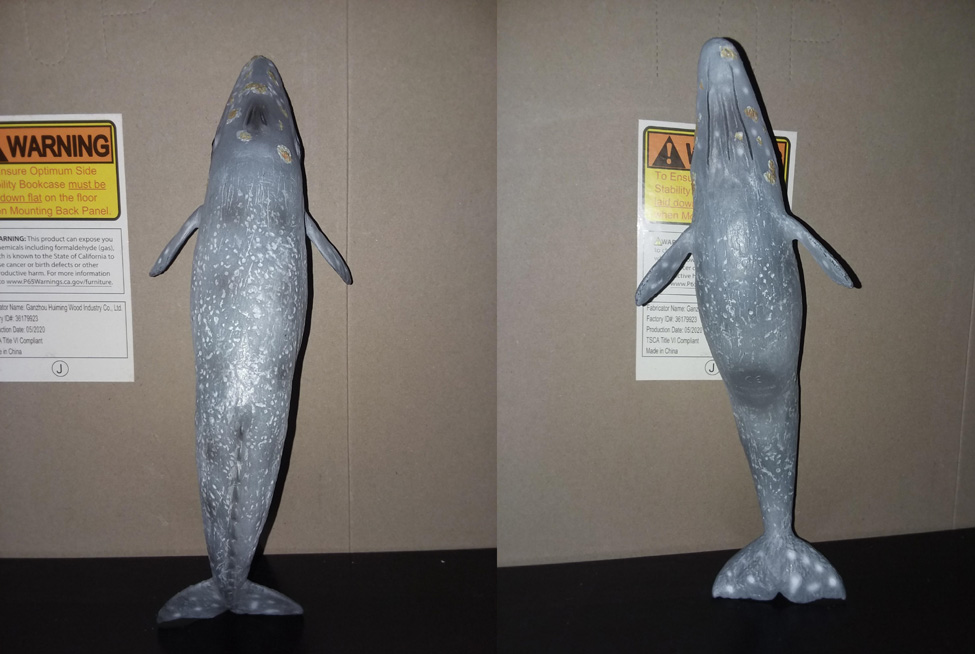
The whale’s contours appear to be very realistic along the dorsal and ventral body. The rostrum and flukes are the correct shapes. The blowhole is properly positioned just ahead of the plane of the eyes. The throat contains 3 sculpted grooves. Gray whales possess far less throat pleats than its rorqual cousins, usually only sporting 2-3 deep grooves along their lower jaw. Now unlike the MBA figure, no genital slits are sculpted on this replica, leaving this figure sex-neutral like its sperm whale counterpart.
Now as for the paintjob, the above photos are of the Mojo Fun 2017 release. Despite being known as the ‘’gray’’ whale, this animal is a bit far from plain-looking and neither is this figure. The base color is a light gray with large white dots for the mottling along the pectoral fins and fluke with tinier dots along most of the body. There are also dark gray patches along the back. The barnacles are given a light-golden hue with white halos.

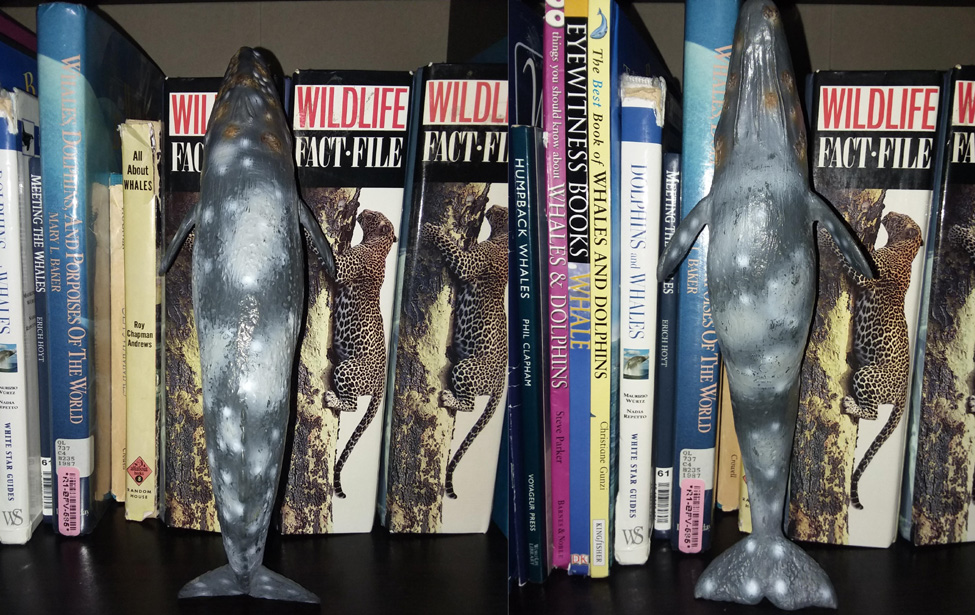
This is one of the major variants of the Schleich release. Here, the coloration is more complex, with portions of the body varying from dark to light gray. The mottling is composed entirely of large white spots throughout the body and the barnacles are more of a golden-brown color. This figure has a noticeably glossier finish while the Mojo fun release has a matte paintjob.
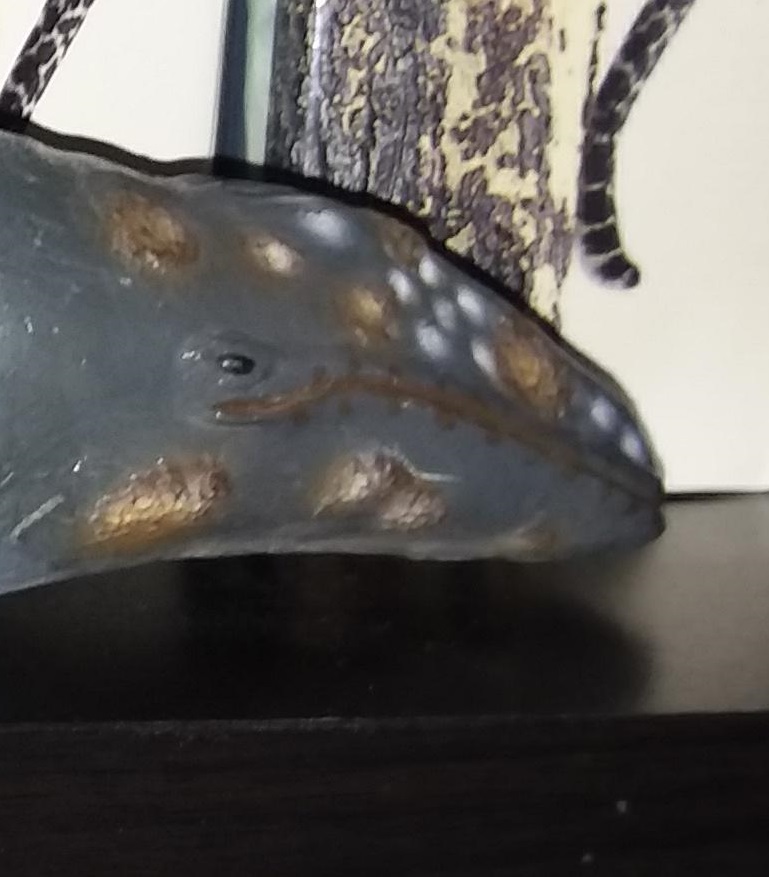
An interesting detail of note is there are black lines around the lips that remind me of the white circles on the lower jaw of the Schleich sperm whale. These odd markings seem to be some stylized way of representing the baleen much like how the white spots on the sperm whale seem to be reflecting the position of the teeth.

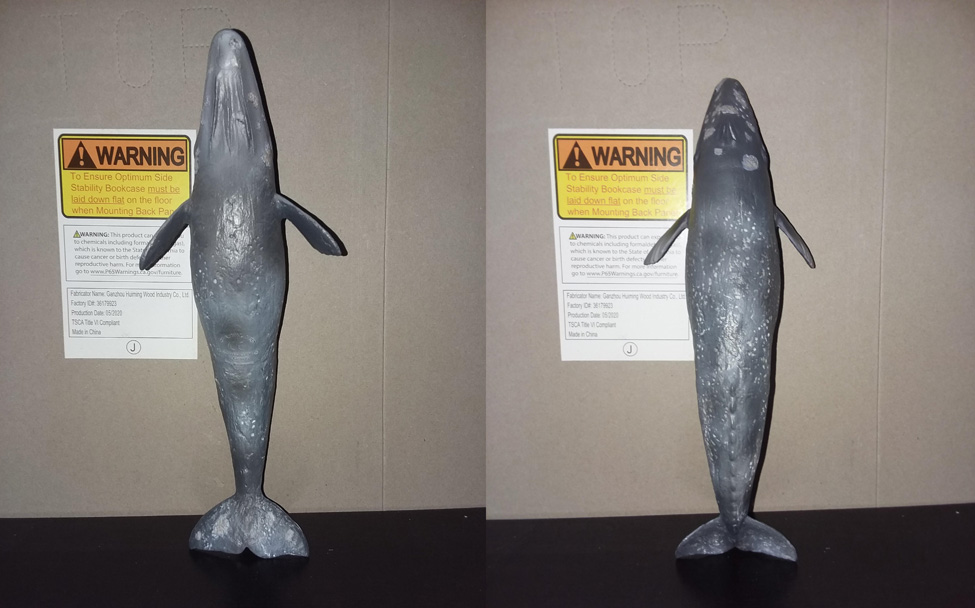
Here’s another version (version 1) of the Schleich gray whale, which I included in this comparison since this paintjob seems to share more of its DNA with the Mojo release. The base color is also multiple shades of gray, but with less contrast as the previous Schleich figure. Like the Mojo figure, it shares a matte paintjob, tiny white dots for the mottling of the main body, and dark patches along the back. However, where it differs from the other two is the gray coloration of the barnacles (though it may be that the colors have faded over time) and the lack of mottling along the flukes and pectoral fins. It also lacks the weird mouth-markings present on the other paintjob.

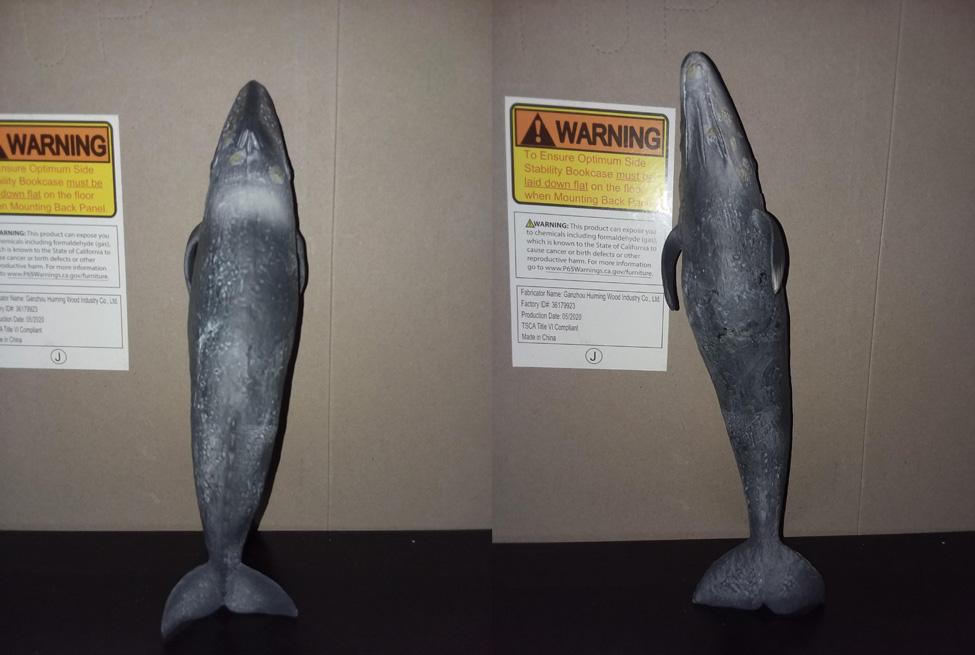
And now for the last one, the bootleg figure I came across. Now due to being a cheaper cast, some of the skin is warped and seams are more noticeable. The pectoral fins and flukes are also noticeably bent as well. The base color is similar to the matte-Schleich figure with a faded yellow for the barnacles and contains little to no mottling. The creases for the blowholes and throat grooves were also not properly painted. Out of all the three, it expectedly had the weakest paintjob due to the lack of polish in areas.
Between all of these paintjobs, I would say the best one comes down to the either the Mojo Fun figure or the glossy-Schleich figure, as those are the most detailed paintjobs. Even then, both the matte Schleich and the bootleg manage to be convincing representations of the animal as the gray whale does display notable variation in coloration and mottling. So in the end, it’s actually difficult to mess up a gray whale paintjob.
Overall, I consider the Maia & Borges gray whale sculpt to be the best in the market. It looks very realistic and is honestly the most successful sculpt out of all of the whales from this manufacturer. The Mojo fun figure is still in production and can be purchased from most retailers. The Schleich releases will require scouring for secondhand sellers. The bootleg can be found on multiple generic bundles of other re-used sculpts from name-brands.
Disclaimer: links to Ebay and Amazon on the AnimalToyBlog are affiliate links, so we make a small commission if you use them. Thanks for supporting us!



